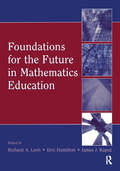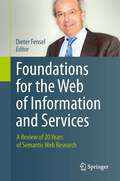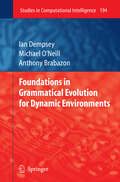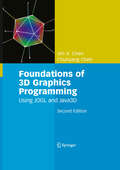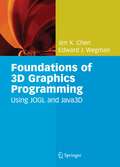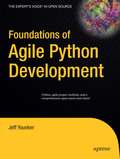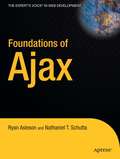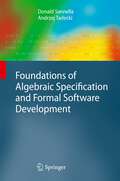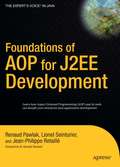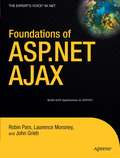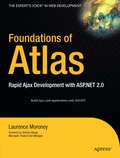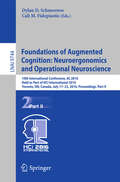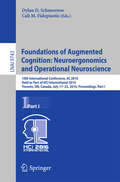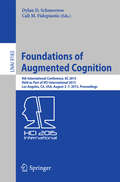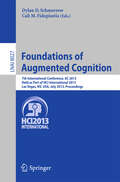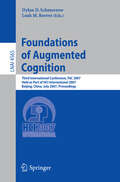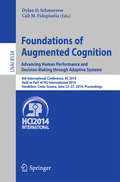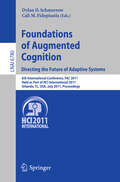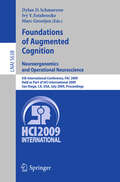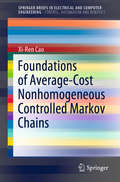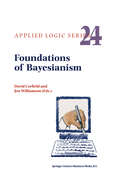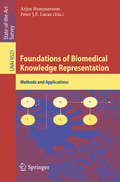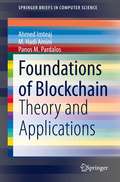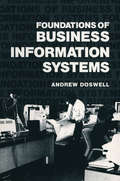- Table View
- List View
Foundations for the Future in Mathematics Education
by Richard A. Lesh Eric Hamilton James J. KaputThe central question addressed in Foundations for the Future in Mathematics Education is this: What kind of understandings and abilities should be emphasized to decrease mismatches between the narrow band of mathematical understandings and abilities that are emphasized in mathematics classrooms and tests, and those that are needed for success beyond school in the 21st century? This is an urgent question. In fields ranging from aeronautical engineering to agriculture, and from biotechnologies to business administration, outside advisors to future-oriented university programs increasingly emphasize the fact that, beyond school, the nature of problem-solving activities has changed dramatically during the past twenty years, as powerful tools for computation, conceptualization, and communication have led to fundamental changes in the levels and types of mathematical understandings and abilities that are needed for success in such fields. For K-12 students and teachers, questions about the changing nature of mathematics (and mathematical thinking beyond school) might be rephrased to ask: If the goal is to create a mathematics curriculum that will be adequate to prepare students for informed citizenship—as well as preparing them for career opportunities in learning organizations, in knowledge economies, in an age of increasing globalization—how should traditional conceptions of the 3Rs be extended or reconceived? Overall, this book suggests that it is not enough to simply make incremental changes in the existing curriculum whose traditions developed out of the needs of industrial societies. The authors, beyond simply stating conclusions from their research, use results from it to describe promising directions for a research agenda related to this question. The volume is organized in three sections: *Part I focuses on naturalistic observations aimed at clarifying what kind of “mathematical thinking” people really do when they are engaged in “real life” problem solving or decision making situations beyond school. *Part II shifts attention toward changes that have occurred in kinds of elementary-but-powerful mathematical concepts, topics, and tools that have evolved recently—and that could replace past notions of “basics” by providing new foundations for the future. This section also initiates discussions about what it means to “understand” the preceding ideas and abilities. *Part III extends these discussions about meaning and understanding—and emphasizes teaching experiments aimed at investigating how instructional activities can be designed to facilitate the development of the preceding ideas and abilities. Foundations for the Future in Mathematics Education is an essential reference for researchers, curriculum developers, assessment experts, and teacher educators across the fields of mathematics and science education.
Foundations for the Future in Mathematics Education
by Richard A. Lesh; Eric Hamilton; James J. KaputThe central question addressed in Foundations for the Future in Mathematics Education is this: What kind of understandings and abilities should be emphasized to decrease mismatches between the narrow band of mathematical understandings and abilities that are emphasized in mathematics classrooms and tests, and those that are needed for success beyond school in the 21st century? This is an urgent question. In fields ranging from aeronautical engineering to agriculture, and from biotechnologies to business administration, outside advisors to future-oriented university programs increasingly emphasize the fact that, beyond school, the nature of problem-solving activities has changed dramatically during the past twenty years, as powerful tools for computation, conceptualization, and communication have led to fundamental changes in the levels and types of mathematical understandings and abilities that are needed for success in such fields. For K-12 students and teachers, questions about the changing nature of mathematics (and mathematical thinking beyond school) might be rephrased to ask: If the goal is to create a mathematics curriculum that will be adequate to prepare students for informed citizenship—as well as preparing them for career opportunities in learning organizations, in knowledge economies, in an age of increasing globalization—how should traditional conceptions of the 3Rs be extended or reconceived? Overall, this book suggests that it is not enough to simply make incremental changes in the existing curriculum whose traditions developed out of the needs of industrial societies. The authors, beyond simply stating conclusions from their research, use results from it to describe promising directions for a research agenda related to this question. The volume is organized in three sections: *Part I focuses on naturalistic observations aimed at clarifying what kind of “mathematical thinking” people really do when they are engaged in “real life” problem solving or decision making situations beyond school. *Part II shifts attention toward changes that have occurred in kinds of elementary-but-powerful mathematical concepts, topics, and tools that have evolved recently—and that could replace past notions of “basics” by providing new foundations for the future. This section also initiates discussions about what it means to “understand” the preceding ideas and abilities. *Part III extends these discussions about meaning and understanding—and emphasizes teaching experiments aimed at investigating how instructional activities can be designed to facilitate the development of the preceding ideas and abilities. Foundations for the Future in Mathematics Education is an essential reference for researchers, curriculum developers, assessment experts, and teacher educators across the fields of mathematics and science education.
Foundations for the Web of Information and Services: A Review of 20 Years of Semantic Web Research
by Dieter FenselIn the mid 1990s, Tim Berners-Lee had the idea of developing the World Wide Web into a „Semantic Web“, a web of information that could be interpreted by machines in order to allow the automatic exploitation of data, which until then had to be done by humans manually.One of the first people to research topics related to the Semantic Web was Professor Rudi Studer. From the beginning, Rudi drove projects like ONTOBROKER and On-to-Knowledge, which later resulted in W3C standards such as RDF and OWL. By the late 1990s, Rudi had established a research group at the University of Karlsruhe, which later became the nucleus and breeding ground for Semantic Web research, and many of today’s well-known research groups were either founded by his disciples or benefited from close cooperation with this think tank.In this book, published in celebration of Rudi’s 60th birthday, many of his colleagues look back on the main research results achieved during the last 20 years. Under the editorship of Dieter Fensel, once one of Rudi’s early PhD students, an impressive list of contributors and contributions has been collected, covering areas like Knowledge Management, Ontology Engineering, Service Management, and Semantic Search.Overall, this book provides an excellent overview of the state of the art in Semantic Web research, by combining historical roots with the latest results, which may finally make the dream of a “Web of knowledge, software and services” come true.
Foundations in Grammatical Evolution for Dynamic Environments (Studies in Computational Intelligence #194)
by Ian Dempsey Michael O'Neill Anthony BrabazonDynamic environments abound, encompassing many real-world problems in fields as diverse as finance, engineering, biology and business. A vibrant research literature has emerged which takes inspiration from evolutionary processes to develop problem-solvers for these environments. 'Foundations in Grammatical Evolution for Dynamic Environments' is a cutting edge volume illustrating current state of the art in applying grammar-based evolutionary computation to solve real-world problems in dynamic environments. The book provides a clear introduction to dynamic environments and the types of change that can occur. This is followed by a detailed description of evolutionary computation, concentrating on the powerful Grammatical Evolution methodology. It continues by addressing fundamental issues facing all Evolutionary Algorithms in dynamic problems, such as how to adapt and generate constants, how to enhance evolvability and maintain diversity. Finally, the developed methods are illustrated with application to the real-world dynamic problem of trading on financial time-series. The book was written to be accessible to a wide audience and should be of interest to practitioners, academics and students, who are seeking to apply grammar-based evolutionary algorithms to solve problems in dynamic environments. 'Foundations in Grammatical Evolution for Dynamic Environments' is the second book dedicated to the topic of Grammatical Evolution.
Foundations of 3D Graphics Programming: Using JOGL and Java3D
by Jim X. Chen Chunyang ChenOpenGL, which has been bound in C, is a seasoned graphics library for scientists and engineers. As we know, Java is a rapidly growing language becoming the de facto standard of Computer Science learning and application development platform as many undergraduate computer science programs are adopting Java in place of C/C++. Released by Sun Microsystems in June 2003, the recent OpenGL binding with Java, JOGL, provides students, scientists, and engineers a new venue of graphics learning, research, and applications. Overview This book aims to be a shortcut to graphics theory and programming in JOGL. Specifically, it covers OpenGL programming in Java, using JOGL, along with concise computer graphics theories. It covers all graphics basics and several advanced topics without including some implementation details that are not necessary in graphics applications. It also covers some basic concepts in Java programming for C/C++ programmers. It is designed as a textbook for students who know programming basics already. It is an excellent shortcut to learn 3D graphics for scientists and engineers who understand Java programming. It is also a good reference for C/C++ graphics vi Preface programmers to learn Java and JOGL. This book is a companion to Guide to Graphics Software Tools (Springer-Verlag, New York, ISBN 0-387-95049-4), which covers a smaller graphics area with similar examples in C but has a comprehensive list of graphics software tools. Organization and Features This book concisely introduces graphics theory and programming in Java with JOGL.
Foundations of 3D Graphics Programming: Using JOGL and Java3D
by Jim X. Chen Edward J. WegmanThis new reference text offers a shortcut to graphics theory and programming using JOGL, a new vehicle of 3D graphics programming in Java. It covers all graphics basics and several advanced topics, without including some implementation details that are not necessary in graphics applications. It also covers some basic concepts in Java programming for C/C++ programmers. The book is designed as quick manual for scientists and engineers who understand Java programming to learn 3D graphics, and serves as a concise 3D graphics textbook for students who know programming basics already.
Foundations of Agile Python Development
by Jeff YounkerThe agile development movement represents the latest advances in tools and techniques intended to boost developer productivity. This is the first book to apply these sought after principles to Python developers, introducing both the tools and techniques built and supported by the Python community. Authored by Jeff Younker, who is perhaps best known for his creation of a popular Python testing framework, this book is sure to be a hit among readers who may have reached their limits of knowledge regarding the Python language, yet are seeking to improve their understanding of how sound processes can boost productivity to unparalleled heights.
Foundations of Ajax
by Nathaniel Schutta Ryan Asleson* Ajax is one of the hottest topics in the developer community right now! and this will be the first Ajax book that offers detailed explanation of how Ajax works and how to use it to best effect. Theory and practice covered immediately in one volume. * Ajax works across many platforms and different groups of developers – this book is designed to be suitable for all those developers across all those platforms, who are interested in the hot new topic of Ajax. * Demand for Ajax knowledge will be strong. Leading technology companies like Google, Yahoo, Adaptive Path, and Amazon are adopting Ajax techniques, and many other companies are doing the same in order to compete with Ajax. This book connect the developer community to the new Ajax functionality.
Foundations of Algebraic Specification and Formal Software Development (Monographs in Theoretical Computer Science. An EATCS Series)
by Donald Sannella Andrzej TarleckiThis book provides foundations for software specification and formal software development from the perspective of work on algebraic specification, concentrating on developing basic concepts and studying their fundamental properties. These foundations are built on a solid mathematical basis, using elements of universal algebra, category theory and logic, and this mathematical toolbox provides a convenient language for precisely formulating the concepts involved in software specification and development. Once formally defined, these notions become subject to mathematical investigation, and this interplay between mathematics and software engineering yields results that are mathematically interesting, conceptually revealing, and practically useful. The theory presented by the authors has its origins in work on algebraic specifications that started in the early 1970s, and their treatment is comprehensive. This book contains five kinds of material: the requisite mathematical foundations; traditional algebraic specifications; elements of the theory of institutions; formal specification and development; and proof methods. While the book is self-contained, mathematical maturity and familiarity with the problems of software engineering is required; and in the examples that directly relate to programming, the authors assume acquaintance with the concepts of functional programming. The book will be of value to researchers and advanced graduate students in the areas of programming and theoretical computer science.
Foundations of AOP for J2EE Development
by Lionel Seinturier Renaud Pawlak* The concepts of AOP are presented independently of any particular implementation * The book covers all 4 major existing tools for AOP: AspectJ, JBoss AOP, AspectWerkz, JAC * The book covers the implementation of a technical aspect based on the Hibernate object/relational persistence framework, a J2EE application implemented with AspectJ, and applications of AOP in the domains of programming by contracts, program testing, and application management
Foundations of ASP.NET AJAX
by Laurence Moroney Robin Pars John GriebASP.NET AJAX combines AJAX with ASP.NET technology and provides a unified set of development tools within Visual Studio 2005. For the first time, AJAX applications can be developed seamlessly in conjunction with a supporting technology. This book gives readers a deep and detailed grounding in how ASP.NET AJAX works. It takes readers swiftly through the first principals of AJAX, and deep into the heart of the technology where every namespace is discussed and every function considered. By the end of the book readers will know everything that they need to confidently produce cutting-edge ASP.NET AJAX applications swiftly and professionally.
Foundations of Atlas: Rapid Ajax Development with ASP.NET 2.0
by Laurence MoroneyThere is huge interest in Ajax and Atlas. This book will demystify the technology and show people how to apply it. First book to be published on this revolutionary new technology. Written by an experienced .NET author working in close collaboration with the Atlas development team
Foundations of Augmented Cognition: 10th International Conference, AC 2016, Held as Part of HCI International 2016, Toronto, ON, Canada, July 17-22, 2016, Proceedings, Part II (Lecture Notes in Computer Science #9744)
by Dylan D. Schmorrow Cali M. FidopiastisThis volume constitutes the refereed proceedings of the 10th International Conference on Foundations of Augmented Cognition, AC 2016, held as part of the 18th International Conference on Human-Computer Interaction, HCII 2016, which took place in Toronto, Canada, in July 2016. HCII 2016 received a total of 4354 submissions, of which 1287 papers were accepted for publication after a careful reviewing process. The 41 papers presented in this volume were organized in topical sections named: augmented cognition in training and education; human cognition and behavior in complex tasks and environments; interaction in augmented cognition; and social cognition.
Foundations of Augmented Cognition: 10th International Conference, AC 2016, Held as Part of HCI International 2016, Toronto, ON, Canada, July 17-22, 2016, Proceedings, Part I (Lecture Notes in Computer Science #9743)
by Dylan D. Schmorrow Cali M. FidopiastisThis volume constitutes the refereed proceedings of the 10th International Conference on Foundations of Augmented Cognition, AC 2016, held as part of the 18th International Conference on Human-Computer Interaction, HCII 2016, which took place in Toronto, Canada, in July 2016. HCII 2016 received a total of 4354 submissions, of which 1287 papers were accepted for publication after a careful reviewing process. The 50 papers presented in this volume were organized in topical sections named: brain-computer interfaces; electroencephalography and brain activity measurement; and cognitive modeling and physiological measuring.
Foundations of Augmented Cognition: 9th International Conference, AC 2015, Held as Part of HCI International 2015, Los Angeles, CA, USA, August 2-7, 2015, Proceedings (Lecture Notes in Computer Science #9183)
by Dylan D. Schmorrow Cali M. FidopiastisThis book constitutes the proceedings of the 9th International Conference on the Foundations of Augmented Cognition, AC 2015, held as part of the 17th International Conference on Human-Computer Interaction, HCII 2015, which took place in Los Angeles, CA, USA, in August 2015. HCII 2015 received a total of 4843 submissions, of which 1462 papers and 246 posters were accepted for publication after a careful reviewing process. These papers address the latest research and development efforts and highlight the human aspects of design and use of computing systems. The papers thoroughly cover the entire field of Human-Computer Interaction, addressing major advances in knowledge and effective use of computers in a variety of application areas. The 78 papers presented in the AC 2015 proceedings address the following major topics: cognitive performance and work load, BCI and operational neuroscience, cognition, perception and emotion measurement, adaptive and tutoring training, applications of augmented cognition.
Foundations of Augmented Cognition: 5th International Conference, AC 2013, Held as Part of HCI International 2013, Las Vegas, NV, USA, July 21-26, 2013, Proceedings (Lecture Notes in Computer Science #8027)
by Dylan D. Schmorrow Cali M. FidopiastisThis book constitutes the refereed proceedings of the 5th International Conference on Augmented Cognition, AC 2013, held as part of the 15th International Conference on Human-Computer Interaction, HCII 2013, held in Las Vegas, USA in July 2013, jointly with 12 other thematically similar conferences. The total of 1666 papers and 303 posters presented at the HCII 2013 conferences was carefully reviewed and selected from 5210 submissions. These papers address the latest research and development efforts and highlight the human aspects of design and use of computing systems. The papers accepted for presentation thoroughly cover the entire field of human-computer interaction, addressing major advances in knowledge and effective use of computers in a variety of application areas. The total of 81 contributions was carefully reviewed and selected for inclusion in the AC proceedings. The papers are organized in the following topical sections: augmented cognition in training and education; team cognition; brain activity measurement; understanding and modeling cognition; cognitive load, stress and fatigue; applications of augmented cognition.
Foundations of Augmented Cognition: Third International Conference, FAC 2007, Held as Part of HCI International 2007, Beijing, China, July 22-27, 2007, Proceedings (Lecture Notes in Computer Science #4565)
by Dylan D. Schmorrow Leah M. ReevesThis book constitutes the refereed proceedings of the Third International Conference on Augmented Cognition, FAC 2007, held in Beijing, China, in July 2007, within the framework of the 12th International Conference on Human-Computer Interaction, HCII 2007, with 8 other thematically similar conferences. It covers general Augmented Cognition methods and techniques and discusses various Augmented Cognition applications.
Foundations of Augmented Cognition. Advancing Human Performance and Decision-Making through Adaptive Systems: 8th International Conference, AC 2014, Held as Part of HCI International 2014, Heraklion, Crete, Greece, June 22-27, 2014, Proceedings (Lecture Notes in Computer Science #8534)
by Dylan D. Schmorrow Cali M. FidopiastisThis book constitutes the proceedings of the 8th International Conference on the Foundations of Augmented Cognition, AC 2014, held as part of HCI International 2014 which took place in Heraklion, Crete, Greece, in June 2014 and incorporated 14 conferences which similar thematic areas. HCII 2014 received a total of 4766 submissions, of which 1476 papers and 220 posters were accepted for publication after a careful reviewing process. These papers address the latest research and development efforts and highlight the human aspects of design and use of computing systems. The papers thoroughly cover the entire field of Human-Computer Interaction, addressing major advances in knowledge and effective use of computers in a variety of application areas. The 34 papers presented in the AC 2014 proceedings are organized in topical sections named: emotional and cognitive issues in augmented cognition; machine learning for augmented cognition; augmented cognition for learning and training and augmented cognition for health and rehabilitation.
Foundations of Augmented Cognition. Directing the Future of Adaptive Systems: 6th International Conference, FAC 2011, Held as Part of HCI International 2011, Orlando, FL, USA, July 9-14, 2011, Proceedings (Lecture Notes in Computer Science #6780)
by Dylan D. Schmorrow Cali M. FidopiastisThis book constitutes the refereed proceedings of the 6th International Conference on Augmented Cognition, FAC 2011, held in Orlando, FL, USA in July 2011, within the framework of the 14th International Conference on Human-Computer Interaction, HCII 2011, with 11 other thematically similar conferences. The 75 full papers presented were carefully reviewed and selected from numerous submissions. The papers are organized in topical parts on theories, models, and technologies for augmented cognition; neuroscience and brain monitoring; augmented cognition, social computing, and collaboration; augmented cognition for learning; augmented cognition and interaction; and augmented cognition in complex environments.
Foundations of Augmented Cognition. Neuroergonomics and Operational Neuroscience: 5th International Conference, FAC 2009, Held as Part of HCI International 2009 San Diego, CA, USA, July 19-24, 2009, Proceedings (Lecture Notes in Computer Science #5638)
by Dylan D. Schmorrow Ivy V. Estabrooke Marc GrootjenThe 13th International Conference on Human–Computer Interaction, HCI Inter- tional 2009, was held in San Diego, California, USA, July 19–24, 2009, jointly with the Symposium on Human Interface (Japan) 2009, the 8th International Conference on Engineering Psychology and Cognitive Ergonomics, the 5th International Conference on Universal Access in Human–Computer Interaction, the Third International Conf- ence on Virtual and Mixed Reality, the Third International Conference on Internati- alization, Design and Global Development, the Third International Conference on Online Communities and Social Computing, the 5th International Conference on Augmented Cognition, the Second International Conference on Digital Human Mod- ing, and the First International Conference on Human Centered Design. A total of 4,348 individuals from academia, research institutes, industry and gove- mental agencies from 73 countries submitted contributions, and 1,397 papers that were judged to be of high scientific quality were included in the program. These papers - dress the latest research and development efforts and highlight the human aspects of the design and use of computing systems. The papers accepted for presentation thoroughly cover the entire field of human–computer interaction, addressing major advances in knowledge and effective use of computers in a variety of application areas.
Foundations of Average-Cost Nonhomogeneous Controlled Markov Chains (SpringerBriefs in Electrical and Computer Engineering)
by Xi-Ren CaoThis Springer brief addresses the challenges encountered in the study of the optimization of time-nonhomogeneous Markov chains. It develops new insights and new methodologies for systems in which concepts such as stationarity, ergodicity, periodicity and connectivity do not apply. This brief introduces the novel concept of confluencity and applies a relative optimization approach. It develops a comprehensive theory for optimization of the long-run average of time-nonhomogeneous Markov chains. The book shows that confluencity is the most fundamental concept in optimization, and that relative optimization is more suitable for treating the systems under consideration than standard ideas of dynamic programming. Using confluencity and relative optimization, the author classifies states as confluent or branching and shows how the under-selectivity issue of the long-run average can be easily addressed, multi-class optimization implemented, and Nth biases and Blackwell optimality conditions derived. These results are presented in a book for the first time and so may enhance the understanding of optimization and motivate new research ideas in the area.
Foundations of Bayesianism (Applied Logic Series #24)
by D. Corfield J. WilliamsonThis is an authoritative collection of papers addressing the key challenges that face the Bayesian interpretation of probability today. The volume includes important criticisms of Bayesian reasoning and gives an insight into some of the points of disagreement amongst advocates of the Bayesian approach. It will be of interest to graduate students, researchers, those involved with the applications of Bayesian reasoning, and philosophers.
Foundations of Biomedical Knowledge Representation: Methods and Applications (Lecture Notes in Computer Science #9521)
by Arjen Hommersom Peter J.F. LucasMedicine and health care are currently faced with a significant rise in their complexity. This is partly due to the progress made during the past three decades in the fundamental biological understanding of the causes of health and disease at the molecular, (sub)cellular, and organ level. Since the end of the 1970s, when knowledge representation and reasoning in the biomedical field became a separate area of research, huge progress has been made in the development of methods and tools that are finally able to impact on the way medicine is being practiced. Even though there are huge differences in the techniques and methods used by biomedical researchers, there is now an increasing tendency to share research results in terms of formal knowledge representation methods, such as ontologies, statistical models, network models, and mathematical models. As there is an urgent need for health-care professionals to make better decisions, computer-based support using this knowledge is now becoming increasingly important. It may also be the only way to integrate research results from the different parts of the spectrum of biomedical and clinical research. The aim of this book is to shed light on developments in knowledge representation at different levels of biomedical application, ranging from human biology to clinical guidelines, and using different techniques, from probability theory and differential equations to logic. The book starts with two introductory chapters followed by 18 contributions organized in the following topical sections: diagnosis of disease; monitoring of health and disease and conformance; assessment of health and personalization; prediction and prognosis of health and disease; treatment of disease; and recommendations.
Foundations of Blockchain: Theory and Applications (SpringerBriefs in Computer Science)
by Ahmed Imteaj M. Hadi Amini Panos M. PardalosThis book provides a comprehensive analysis of fundamental topics related to blockchain. Throughout, the authors explore different vital issues and specific areas of blockchain. For convenience, the authors present the elementary description, visualize the working procedure of blockchain paradigm, and highlight the areas it can be applied in real life. They explain the blockchain process from a diverse perspective i.e. distributed Internet of Things (IoT), interdependent networks, intelligent mining, etc. They also analyze the interconnection of a blockchain network and such novel research areas to show a pathway towards a new research direction. This book also holds the core challenges and open research issues of blockchain technology, considering existing applications. Chapters include consensus mechanisms of blockchain, blockchain applicability in centralized and decentralized internet of things, blockchain interoperability from the perspective of interdependent networks, and blockchain for resource-constrained devices.Specifies the importance of theoretical methods in dealing with problems in the context of blockchain for interdependent decision making;Provides a comprehensive investigation of blockchain algorithms and the recently developed methods based on this algorithm;Provides basics and mathematical foundations needed to learn and deploy blockchain.
Foundations of Business Information Systems (Approaches to Information Technology)
by Andrew DoswellA few years ago there were no books on information technology and business, now there are a great many. To add to that flow calls for courage and judgment on the part of both a potential author and publisher. Andrew Doswell and Plenum Press are justified in bringing this work into the market. The main reason is that Andrew Doswell has brought to the work some simple yet formidable attributes. The first of these is that he knows what he is talking about. He was trained as an electrical engineer; he then was employed in business, drawing on and fortifying that training, where he moved into an administrative position. Later still he moved into teaching, first in Ireland, then in Scotland, but while employed in education he has not become an academic recluse. On the contrary, he has continued to maintain his links with business, doing so by engaging in both research and consultancy. Within the University he has been at the forefront of our thrust into office automation and office information systems.
